When you grow your own melons at home, you get to choose from a delicious array of options.
If you think you don’t have the right conditions to grow these fruits, or have been underwhelmed by melons in the past, maybe it’s time to consider some new varieties.
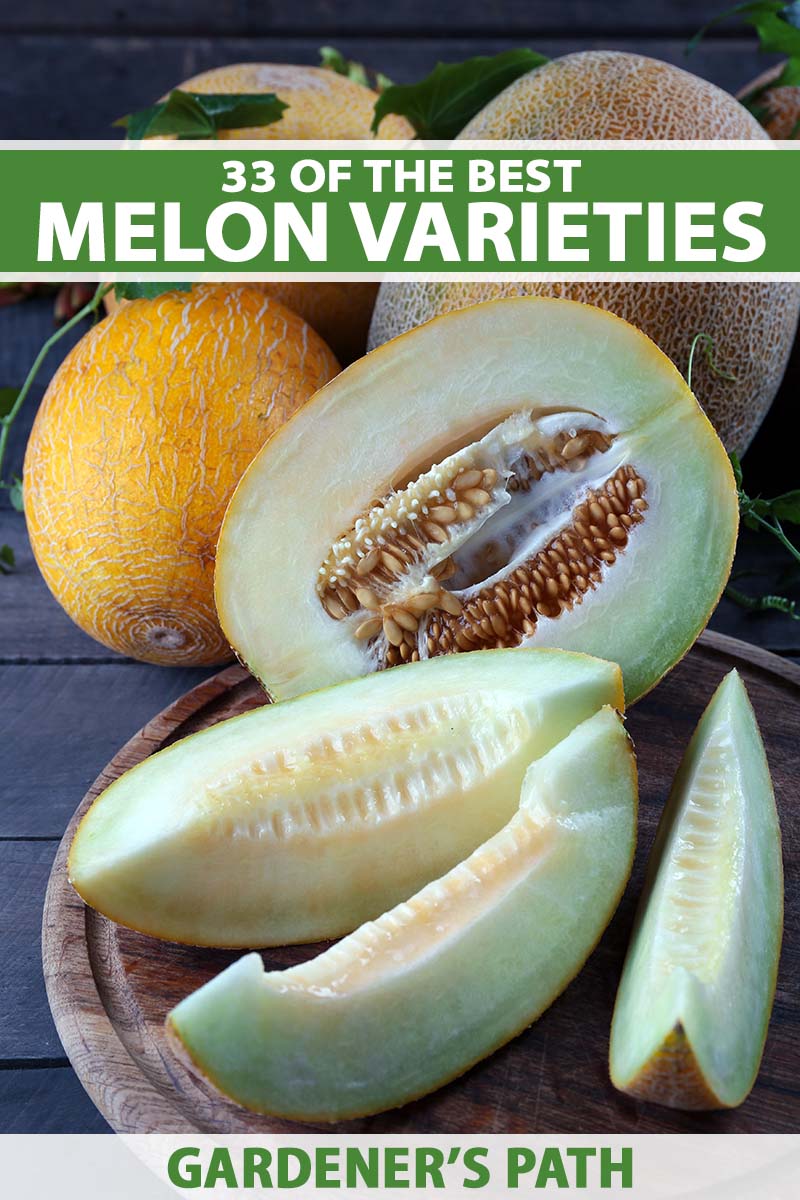
We link to vendors to help you find relevant products. If you buy from one of our links, we may earn a commission.
I’m going to provide you with a selection of sweet and delicious melons that will please many different palates, including cultivars adapted to a variety of climates.
Maybe you’re looking for a melon that will tolerate cool nights – or one for hot and humid weather?
Perhaps you’re looking for a small-fruited cultivar to grow on a trellis – or maybe you want to take advantage of your long growing season to grow larger fruits?
Whether you prefer tropical flavors or notes of warming spice, and a crisp or meltingly soft texture, I bet you’ll find a variety or two among this selection that will not only work in your garden but also tempt your tastebuds.
If you’re not yet convinced, let me divulge something here: I come from the other side.
I spent half my life avoiding melon because every time I tasted a chunk of honeydew or cantaloupe, it was always dull and bland – all texture, and no taste.
It wasn’t until a return flight from a vacation in Hawaii that I learned that melons could actually be delectable. What a surprise – and it came in the most unexpected form – airplane food.
This realization changed my perspective on these fruits, and ever since I’ve been on a quest for melon bliss. The good news is you don’t have to wait for that once-in-a-lifetime Hawaiian vacation to taste amazing melons.
Since that revelatory moment at 30,000 feet, I have been growing my own, and have harvested fruits that were just as tasty, if not more so.

So it is with unbounded joy and abandon that every year now, I select a fantastic assortment of delicious melon cultivars to sow in my own garden.
No more tasteless cantaloupes or honeydews in my life! And you don’t have to settle for them in your life either.
The selections I’ve included here are all varieties of the Cucumis melo species, and they are all sweet. Here’s a sneak peek:
33 Delicious Melon Cultivars
You’ll notice that I’ve organized my selection of cucurbit delicacies into three ripening seasons.
I’ve arranged them in this manner because it’s incredibly frustrating to sow a melon plant from seed and take care of it for months, only to have the vine be killed back by frost before the fruit is anywhere close to being ripe.
To prevent you from experiencing that kind of disappointment, you’ll find these varieties organized by the number of days until they reach peak ripeness:
- Early varieties mature in less than 85 days.
- Mid-season varieties will ripen in 85 to 95 days.
- Late varieties require 100 days or more until harvest.
Now all you have to do is check the length of your growing season and choose from the cultivars that will reach maturity well within that period of time.
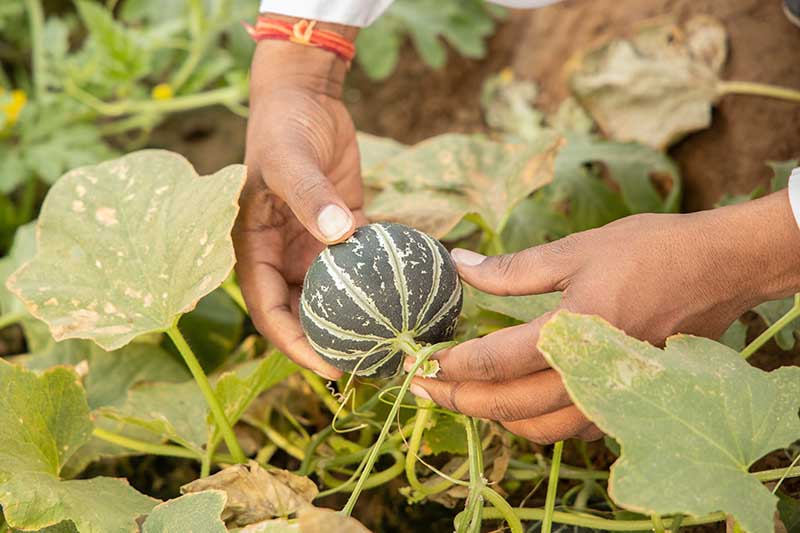
Not sure how long your growing season is? It’s the number of estimated frost-free days between your average last spring frost and your average first fall frost.
In my USDA Hardiness Zone 5b location, I have an average of about 115 frost-free days, which is enough time to grow a late variety only if I’m lucky.
Since that number is only an average, the actual growing season can be much shorter in a given year. So my best bet for producing ripe melons is to choose early and mid-season varieties.
Some of you long-season gardeners might want to choose an early variety for another reason – to harvest your fruit before garden pests take over your melon patch.
In addition to the number of days until harvest, I’ll also describe the flavor, texture, and color of the flesh of each cultivar, what it looks like when ripe, and where you can find seeds.
And whenever possible, I’ll also share the Brix rating for each cultivar.
Taking a Brix measurement is a method that may be used to judge the amount of sugar in a fruit or vegetable – the higher the Brix rating, the sweeter it is. Cultivars in this selection rate between nine and 18 degrees Brix.
Ready to get started?
Early Varieties
First, let’s have a look at the short season cultivars. These early varieties will provide you with ripe fruit in less than 85 days.
1. Amy
Our first variety, ‘Amy,’ is a high-yielding, early canary melon cultivar.
Canary melons are also known as “winter” melons. They tend to ripen late in the season, and have excellent storage properties, serving as a welcome source of fresh fruit in winter.
These fruits are usually large, oval shaped, and have bright yellow rinds. Their flesh tends to be cream-colored, fragrant, and sweet.
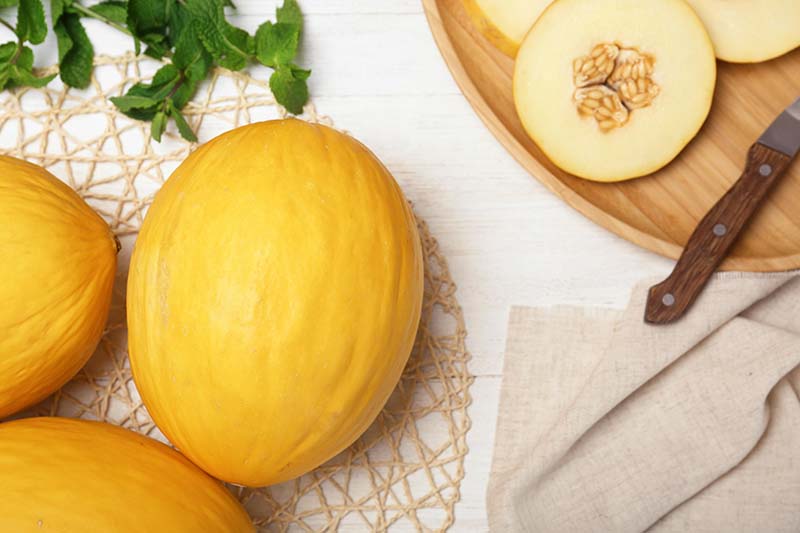
‘Amy’ is a hybrid canary cultivar that is on the smaller side for canaries. When ready to harvest, it has golden skin, and weighs two to four pounds.
Inside you’ll find fragrant white flesh, and a small seed cavity. ‘Amy’ canary melons are sweet with a firm texture.
‘Amy’ won the All-America Selections award in the “edibles” category in 2004.
The vines of this cultivar spread to six feet, grow prolifically, and can be trained to grow on a trellis.
Many canary varieties are late to mature, so ‘Amy’ is a real find, with fruits ripening in just 70 to 80 days.
You’ll find ‘Amy’ seeds available for purchase in packets of various sizes from Mountain Valley Seed Company at True Leaf Market.
2. Bodacious
‘Bodacious’ is a hybrid honeydew that will give you an early harvest of exquisitely flavorful fruit.
Usually late to mature, honeydews should need little introduction. They are known for their crisp green flesh that lacks the musky flavor of cantaloupe.
‘Bodacious’ fruits weigh between five and eight pounds, and have a smooth rind. A slice of these large melons will reveal creamy green flesh that is very sweet, juicy, and soft.
‘Bodacious’ vines can reach seven feet in length, and fruits will be ready to harvest at around 82 days after sowing.
You’ll find ‘Bodacious’ available for purchase in packs of 25 seeds at Burpee.
3. Creme de la Creme
‘Creme de la Creme’ defies classification. This hybrid melon produces six-pound fruits that grow to be seven to eight inches wide.
When ripe, the finely netted rind turns a yellowish-orange color. Cut ‘Creme de la Creme’ open and you’ll find pale orange flesh that is sweet and spicy, with notes of nutmeg and cinnamon.
Extremely prolific plants can spread up to 72 inches and grow 15 to 18 inches in height.
A great choice for short season gardeners, ‘Creme de la Creme’ fruit can reach maturity in just 75 days. And harvesting is easy because fruits will slip from the vine when ripe.
4. Earli-Dew
If you are a northern gardener who thought your growing season was too short to grow honeydews, here’s a solution for you: ‘Earli-Dew.’
Introduced in 1978, ‘Earli-Dew’ is an early maturing hybrid honeydew that produces round fruits weighing two to three pounds.
This variety’s smooth green skin turns greenish gold when mature, and its flesh is thick, pale green, and very sweet.
‘Earli-Dew’ plants are vigorous and resistant to fusarium wilt.
Early maturing, as its name suggests, these honeydews will be ready to harvest in around 80 days.
Purchase ‘Earli-Dew’ in packs of ten, one hundred, or five hundred seeds from Mountain Valley Seed Company at True Leaf Market.
5. Gallo
‘Gallo’ is a type of mini Galia melon.
Galia melons originated in Israel, developed by plant breeder Dr. Zvi Karchi. The first ‘Galia’ was a cross between the true cantaloupe ‘Ha Ogen’ and a netted Russian melon called ‘Krymka.’
Dr. Karchi named this cross after his daughter.
While it started as a specific cultivar, galia has now become a type of melon, much like there are many types of lacinato kale or Roma tomatoes.
From the outside, a galia melon looks like a larger than average muskmelon, but cut one open and you will discover juicy, yellowish-green flesh.
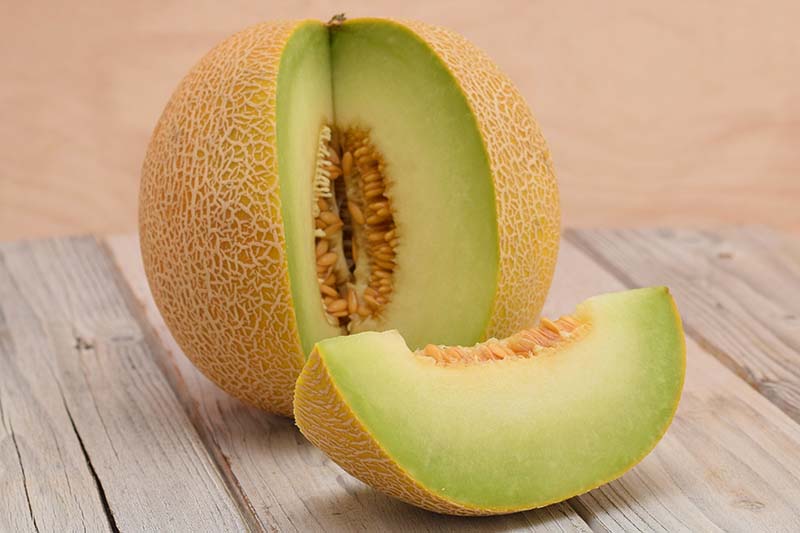
‘Gallo,’ one such type of galia melon, bears fruits that weigh in at around two pounds.
The rind of ‘Gallo’ is dark green and netted, turning golden when it’s ready to harvest.
The pale green flesh of this cultivar is fine-grained, tasty, and very sweet with a 15-degree Brix rating.
Prolific vines grow up to eight feet in length and bear smaller fruits, making this variety great for trellising.
One of the earliest ripening melons you’ll find, ‘Gallo’ reaches maturity in just 70 days.
You’ll find ‘Gallo’ seeds available for purchase in packs of various sizes from Mountain Valley Seed Company at True Leaf Market.
6. Kajari
As far as melons go, ‘Kajari’ may be the fairest of them all – its skin is deep orange or maroon in color with green veins bordered in cream.
‘Kajari’ is a member of the khandalak cultivar group believed to hail from the Punjab region of India and Pakistan.
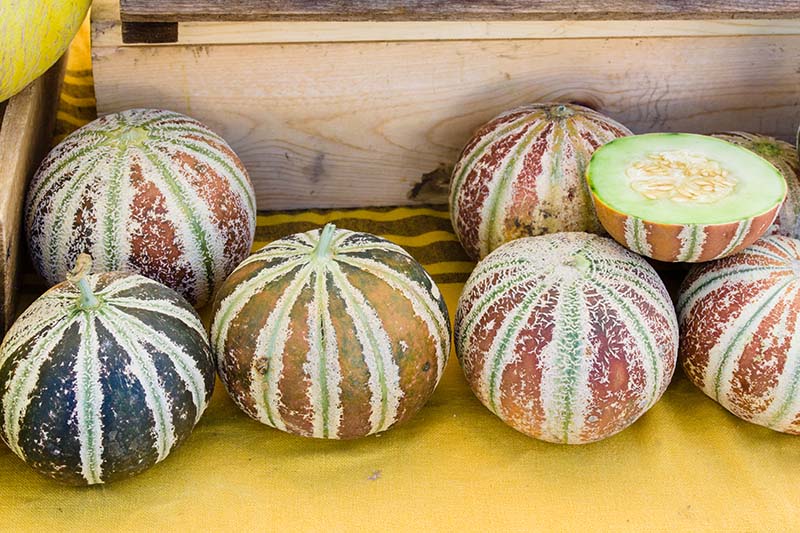
Inside its beautifully patterned skin you’ll find green flesh that has a creamy texture, and is musky and sweet, with sugar content of 11 degrees Brix.
These open-pollinated fruits are on the small side, averaging about two pounds each.
Plants are resistant to powdery mildew and are very prolific, maturing in approximately 70 days.
‘Kajari’ melons have a short shelf life, so don’t put these away for later, enjoy them soon after harvest.
You’ll find ‘Kajari’ available for purchase in packs of ten seeds available at Walmart.
7. Mango
‘Mango’ is a melon that doesn’t fit neatly into a cultivar group – it’s a hybrid that has been bred for early maturity, cool weather tolerance, and sweetness.
This cultivar bears fruits that weigh four to five pounds and have yellow skin.
Please note, this ‘Mango’ is not the same “mango melon” that is also known as “vine peach.”
Unlike that mango melon in the chito cultivar group, which is primarily used for pickling or baking due to its lower sugar content, the orange flesh of this ‘Mango’ is very sweet with tropical undertones.
‘Mango’ plants can spread up to ten feet. Their tolerance of cooler weather makes them a good option for those of us with hot days, cool nights, and early fall weather.
This variety slips from the vine when ripe, providing mature fruit in just 80 days.
You’ll find ‘Mango’ available for purchase in packs of 20 seeds at Burpee.
8. Minnesota Midget
‘Minnesota Midget’ is our first muskmelon in this selection, and it is a personal favorite in my household, thanks to its early maturity and delicious sweetness.
Muskmelons are what we call “cantaloupes” in America, though they are not true cantaloupes. Along with the term “muskmelons,” these cultivars are also referred to as “American cantaloupes.”
To make matters a bit confusing, “muskmelon” is sometimes used very broadly, to include true cantaloupes, American cantaloupes, honeydews, and other types of melons.
However, I’m following the Encyclopedia Britannica’s example, using the term only for members of the reticulatus cultivar group.
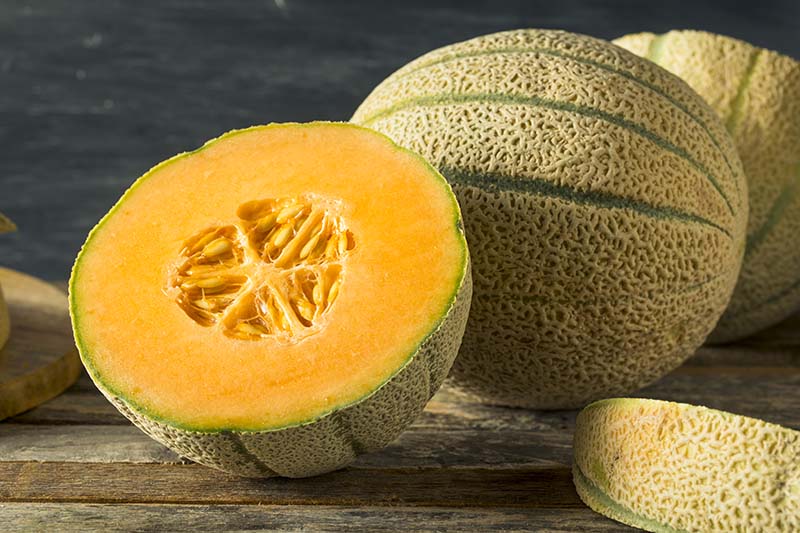
And that brings us to our cultivar selection, ‘Minnesota Midget,’ an open-pollinated heirloom bred at the Minnesota Agricultural Experiment Station in St. Paul, Minnesota, and introduced in 1948.
Adapted to northern climates as their name suggests, ‘Minnesota Midget’ muskmelons weigh about twelve ounces at maturity, and measure roughly three and a half to four inches across – just the right size for two people to share as dessert.
The rind of ‘Minnesota Midget’ is covered with fine netting, and is lightly furrowed.
Once you slice open a ‘Minnesota Midget’ you’ll find orange flesh that is juicy and sweet, with an 11-degree Brix rating.
Plants are resistant to fusarium wilt and produce short vines measuring three feet in length, making them great for container gardening.
Learn more about growing cantaloupes in containers in our article.
This cultivar is early to mature, and therefore great for gardeners with shorter growing seasons. Fruits are ready to pick in just 60 to 75 days.
You’ll find certified organic ‘Minnesota Midget’ seeds available for purchase in one-gram packets at Botanical Interests.
9. Muskateer
Another diminutive melon, ‘Muskateer’ is a honeydew hybrid that bears numerous single serving fruits, each weighing one to two pounds at maturity.
Ripe fruits have smooth, cream-colored rinds, and contain white to pale green colored flesh with a honey sweet flavor.
Prolific plants spread up to 60 inches, bearing small fruits, which makes ‘Muskateer’ an excellent honeydew variety for trellising.
This hybrid honeydew is great for gardeners with short growing seasons, ripening in 75-80 days.
10. Noir des Carmes
‘Noir des Carmes’ is a very old French variety of true cantaloupe that was chosen to be included in the Slow Food Foundation for Biodiversity’s Ark of Taste.
Unlike American cantaloupes, “true cantaloupes” are part of the cantalupensis cultivar group. These cantaloupes usually lack netting and also tend to feature deep furrows or lobes.
And while many true cantaloupes have smooth as opposed to netted skin, some varieties have very warty rinds, reminiscent of heirloom pumpkins. These also tend to be smaller fruit than their American counterparts.
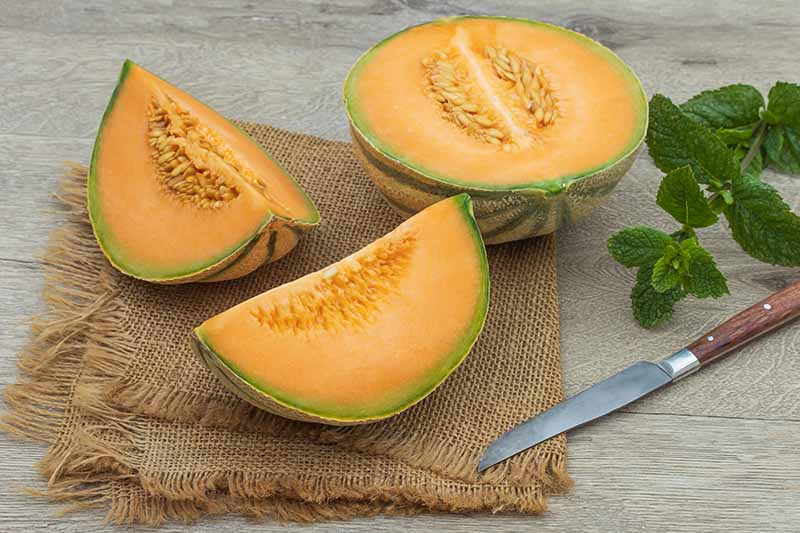
True cantaloupes also tend to lack the characteristic musky taste of American cantaloupes. So if you thought you didn’t like cantaloupe because of its strong taste, you might want to try a true cantaloupe and see what you think.
As for ‘Noir des Carmes,’ this true cantaloupe was named after Carmelite monks who grew them in France, and dates back to at least 1787.
On the scale, the fruits of ‘Noir des Carmes’ come in at about two pounds, and they measure four inches tall and six inches wide.
This open pollinated cantaloupe has a bumpy rind, deep furrows, and looks very much like a pumpkin.
In the US, this variety is also known as ‘Black Rock.’ Unripe fruit have dark green to black skin, turning orange or orange mottled with green when ripe.
The fruits of ‘Noir des Carmes’ smell heavenly and are sweet, with an 11-degree Brix rating.

An early variety, ‘Noir des Carmes’ grows prolifically and only needs 75 to 80 days to reach maturity. These aren’t long keepers and should be eaten rapidly after harvest for best flavor.
You’ll find ‘Noir des Carmes’ seeds available for purchase in a variety of package sizes via Amazon.
11. Tweety
Do you hear the early melon chirping? That would be ‘Tweety.’
‘Tweety’ is an early ripening hybrid canary melon with excellent disease resistance.
The fruit of this cultivar weighs four to six pounds and has smooth, bright yellow skin.
Its flesh is pale green to white, with salmon coloring at the seed cavity. It is crisp and fragrant with a sweet flavor reminiscent of tropical fruit.
‘Tweety’ will grow vines that reach four to five feet in length and are resistant to Alternaria, fusarium wilt, and gummy stem blight.
If you have struggled with bringing melons to maturity in the past, put ‘Tweety’ on your list – the fruit of this cultivar ripens in just 60 to 70 days.
You’ll find ’Tweety’ seeds available for purchase in packs of 25 seeds at Walmart.
Mid-Season Varieties
If you have a bit more wiggle room in your growing season, you might want to choose a mid-season cultivar. These varieties will produce ripe melons in 85-95 days.
12. Ananas
‘Ananas’ is a Middle Eastern heirloom that dates back to the 1800s.
And like the galia type described above, ‘Ananas’ is not only a cultivar, but also a type of melon in the ameri cultivar group, and the parent of other descendent cultivars.
These melons have orange rinds with light netting. Their flesh is usually white, but some varieties are orange fleshed.
Ananas-type melons take their name from the French word for “pineapple,” which is a good way to describe their fragrant aroma.

‘Ananas’ produces oblong fruits that mature to an orange hue overlaid with fine beige netting.
These weigh five to seven pounds, and grow to be seven and a half inches long by six and a half inches wide.
Inside, the fragrant flesh is creamy white and juicy, with a texture similar to that of a pear. Flavorful and sweet, ‘Ananas’ has a Brix rating of 10.5 degrees.
This open-pollinated cultivar is adapted to dryland conditions, where a cool and wet season is followed by a warm and dry season, and brings fruit to maturity in 90 days or less.
You’ll find ‘Ananas’ seeds available for purchase in an array of package sizes at Eden Brothers.
13. Banana
‘Banana’ is a testament to the fact that not all melons need to be round!
Also known as ‘American Banana,’ ‘Banana Citron,’ ‘Cuban Banana,’ and ‘Mexican Banana,’ this open-pollinated cultivar produces long, banana-shaped fruits that can weigh up to nine pounds and measure 18 inches in length.
‘Banana’ has pale, yellowish green skin and soft orange flesh that transitions to firm green towards the rind.
There is some variation in this cultivar and the skin may or may not be netted. Lobes and furrows appear in some fruits, but not all.
Although it looks like a banana, unless you really use your imagination, it still tastes like cantaloupe. This ‘Banana’ is nonetheless sweet, with an 11-degree Brix rating.
‘Banana’ is a mid-season melon, with fruits maturing in 90 days.
You’ll find ‘Banana’ seeds available for purchase in packs of several different sizes at Eden Brothers.
14. Bidwell Casaba
‘Bidwell Casaba’ is the reigning melon champion in my household – if forced to grow only one type of melon every year, my husband and I both agree that this heirloom is the one we would choose.
Like canary melons, casabas are winter melons with excellent storage properties, members of the inodorus cultivar group. They most likely originate in Kasaba, a village in Turkey.
They are large, with yellow rinds and sweet orange or white flesh.
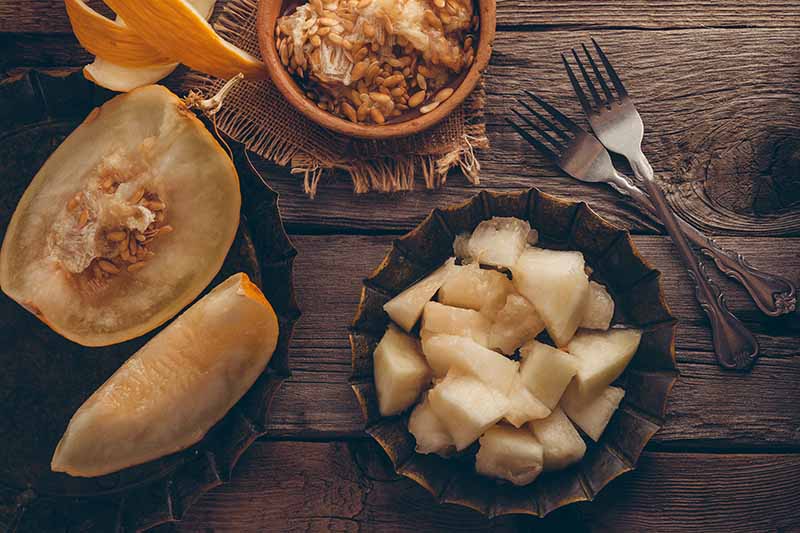
The ‘Bidwell Casaba’ cultivar is also known as ‘Bidwell,’ ‘Bidwell Cassaba,’ and ‘California Casaba.’
It was developed in the 1800s by John Bidwell, a fan of casabas, who was also a US Senator, a general in the American Civil War, and founder of the city of Chico, California.
The fruits of ‘Bidwell Casaba’ can grow to be twelve to sixteen pounds when ripe, and are about fourteen inches long and seven and a half inches wide on average.
These open-pollinated, football-shaped fruits have deep grooves, and turn orange or yellow at maturity, though often retaining green stripes.
They have soft skin, and creamy orange flesh that is sugary and juicy.
‘Bidwell Casaba’ is a mid-season melon, requiring 90-95 days to reach maturity.
15. Collective Farm Woman
‘Collective Farm Woman’ wins a close second place to ‘Bidwell Casaba’ in my household’s personal melon vote-off.
This member of the inodorus cultivar group presents somewhat of a mystery as to how it is related to the other melons here.
It’s not a honeydew, and as far as I have been able to tell, it doesn’t fit nicely into one of the other melon categories either. But it is unquestionably delicious.

One of its cultivar synonyms gives us a clue as to its heritage – in addition to ‘Collective Farm Woman,’ it’s also called ‘Kazakh,’ leaving one to believe it may have origins in Kazakhstan. Its reputation in the US, though, comes from a different country.
According to the seed company Seed Savers Exchange, which in 1993 was the first to sell ‘Collective Farm Woman’ in the US, the seed came from a woman living on a Soviet collective farm or “kolkhoz” in Ukraine.
It’s also known as ‘Kolkhoznitsa,’ which is Russian for “collective farm woman.”
‘Collective Farm Woman’ has smooth skin that ripens to a bright yellow-orange hue. Inside you’ll find cream colored flesh that smells fragrant and has a sweet, floral flavor with a satisfying crunch.
Reflecting its luscious sugar content, its Brix rating is on the higher end, at 13.5 degrees.
The fruits of this open-pollinated heirloom weigh in at two pounds, and measure roughly five inches wide and long.
Being tolerant of cooler weather, ‘Collective Farm Woman’ does great in locations with hot days and cool nights, and matures mid-season, in about 85 days.
When looking for seeds for this variety, you may need to adjust your spelling if you don’t find it – it’s also referred to as ‘Collective Farmwoman.’
You’ll find this cultivar available for purchase in a variety of packet sizes at True Leaf Market.
16. Delice de la Table
And now we come to a melon that, like ‘Kajari,’ is as much of a pleasure to the eyes as it is to the tastebuds.
This heirloom is an old French variety which, as its name ‘Delice de la Table’ suggests, is a real “delight of the table.”
‘Delice de la Table’ is a true cantaloupe whose coloring and shape make these ribbed fruits look like small pumpkins.
They contain reddish orange flesh that is sweet and soft, and can weigh up to six pounds.
Like ‘Noir des Carmes,’ this cantaloupe was also deemed worthy of inclusion in the Slow Food Foundation for Biodiversity’s Ark of Taste.
‘Delice de la Table’ is an open-pollinated, mid-season variety, maturing in 85-90 days.
17. Edisto 47
When Clemson University breeders crossed the ‘Edisto’ and ‘Georgia 47’ cultivars in the 1960s, the result was disease resistant ‘Edisto 47.’
These open-pollinated muskmelons weigh in at three to five pounds and are oval in shape with netted rinds.
‘Edisto 47’ has delicious salmon-colored flesh that is sweet and juicy.
With excellent resistance to hot, humid weather, ‘Edisto 47’ is the perfect choice for climates such as that of the southeastern United States.
Plants produce vigorous vines with large leaves, and are resistant to Alternaria, downy mildew, and powdery mildew. Fruits from this Southern-bred variety mature in around 85 days.
You’ll find ‘Edisto 47’ seeds available for purchase in packs of several different sizes from Mountain Valley Seed Company at True Leaf Market.
18. Ha Ogen
‘Ha Ogen’ is a true cantaloupe from the cantalupensis cultivar group that has green flesh.
This Israeli variety’s name means “the anchor” in Hebrew. It is also known as ‘Ogen,’ ‘Devash Ha’Ogen Number Two,’ or ‘Ha’Ogen Honey Number Two.’
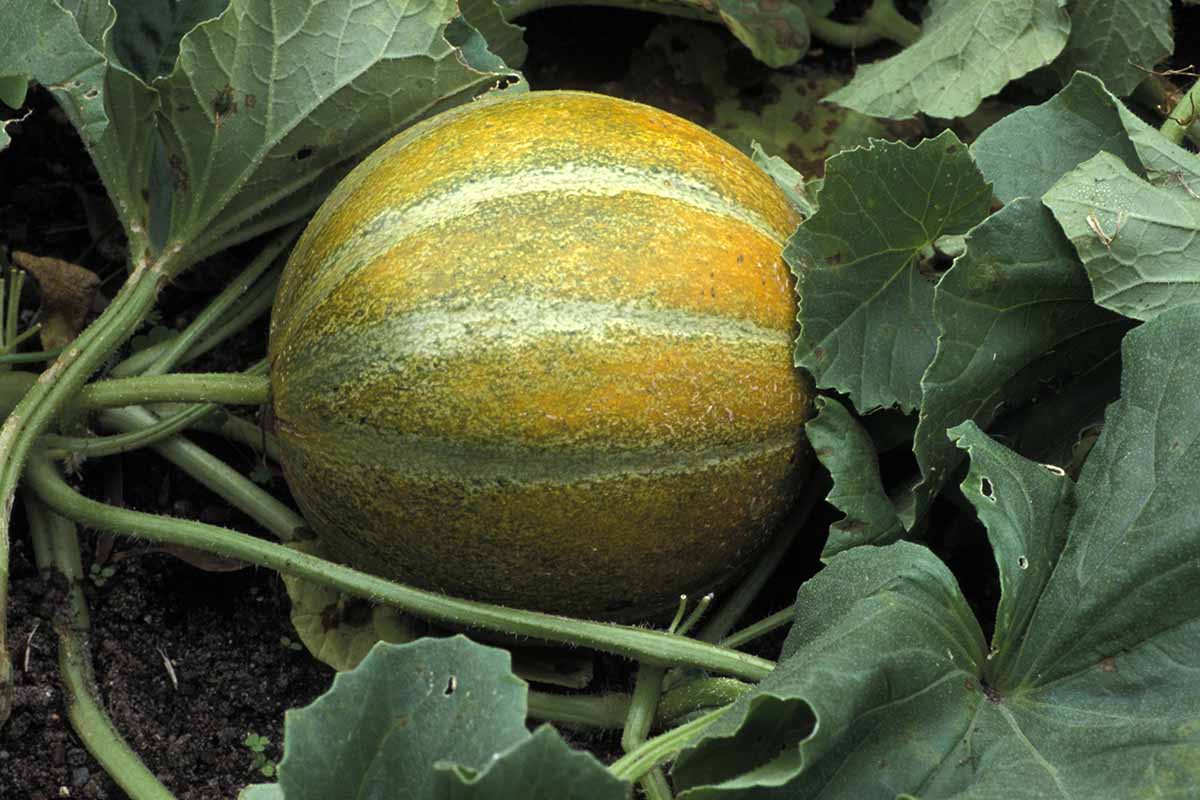
‘Ha Ogen’ melons weigh three to five pounds and measure six inches across.
At maturity, these open-pollinated cantaloupes are yellow or orange with green sutures. Their green flesh transitions to salmon pink at the seed cavity.
And that green flesh has a complex, sweet and warm, spiced flavor, with an 11-degree Brix rating.
This mid-season variety ripens in 80 to 90 days.
19. Hale’s Best Jumbo
‘Hale’s Best Jumbo’ is an heirloom muskmelon that has been a favorite among gardeners since the 1920s.
Its lightly ribbed fruits weigh three to five pounds and are six inches across.
Netted rinds enclose thick walls of sweet, firm orange flesh around a small seed cavity.
Vines can grow to six feet or more, have good heat and drought tolerance, and tend to produce three to five fruits per plant.
A mid-season melon, fruits of this open-pollinated variety are ready to harvest in 85 days.
You’ll find organic ‘Hale’s Best Jumbo’ seeds available for purchase in one-gram packets, enough to sow 16 mounds, at Botanical Interests.
20. Honey Rock
‘Honey Rock’ is a muskmelon or “American cantaloupe” in the reticulatus cultivar group.
This open-pollinated heirloom originated in Michigan and is well adapted to the growing conditions in the northeastern United States and southern Canada.
This cultivar goes by a few other names as well, including ‘Honeyrock,’ ‘New Sugar Rock,’ ‘Sugar Rock,’ ‘Superba,’ and ‘White Seeded Delicious.’
These slightly ribbed fruits weigh three pounds and measure six inches long and wide.
‘Honey Rock’ has thick, coarsely netted skin containing yellowish orange flesh. Fruits are sweet with a 10-degree Brix rating.
In 1933, ‘Honey Rock’ won the All-America Selections gold medal in the edible category.
‘Honey Rock’ plants are resistant to fusarium wilt and hold up well in cooler weather. Each plant bears between five and seven fruits, which ripen in 90 days or less.
You’ll find ‘Honey Rock’ seeds available for purchase in packs ranging from three grams up to five pounds from Mountain Valley Seed Company at True Leaf Market.
21. Papaya Dew
‘Papaya Dew’ is a super sweet hybrid melon that weighs two to four pounds.
The thin skin of this hybrid is smooth and turns from grayish green to yellowish white when ripe. Within that rind is delicious coral-colored flesh.
‘Papaya Dew’ has a high Brix rating, between 14 and 18 degrees, making it potentially the sweetest option in this selection.
It has a tropical flavor, which some describe as a mix between honeydew and cantaloupe.
The vines of this hybrid melon grow to four to five feet long and require up to 90 days for fruits to mature.
22. Piel de Sapo
‘Piel de Sapo’ is a type of casaba melon that’s popular in Spain. It’s also known as ‘Toad Skin’ or ‘Frog Skin,’ both of which are English translations of its Spanish name.
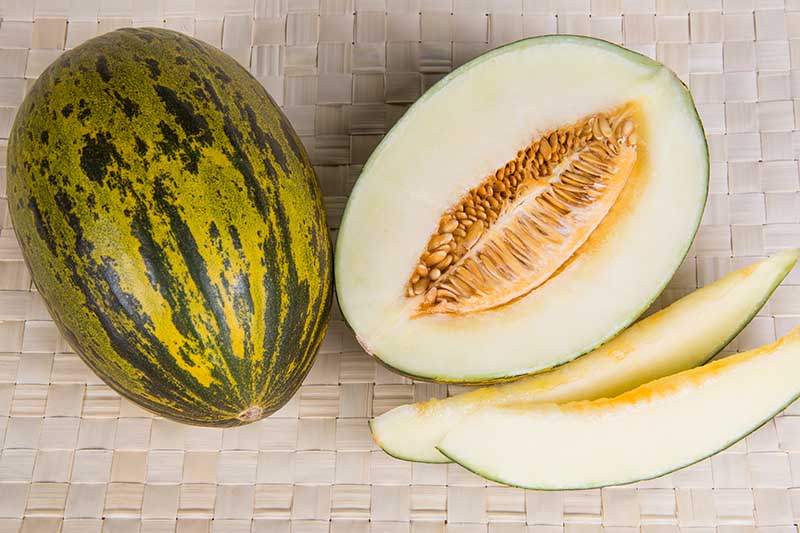
A large oval-shaped melon weighing in at seven to nine pounds, ‘Piel de Sapo’ averages eleven inches long by seven inches wide.
The thick rind of this casaba is a beautiful yellowish green mottled with darker green spots and splotches.
Inside you’ll find pale yellowish green flesh with a bit of orange at the seed cavity. This open-pollinated melon can be very sugary, attaining a 12-degree Brix rating.
‘Piel de Sapo’ performs well under high heat and dry conditions, and provides ripe fruit in 90 days.
You’ll find ‘Piel de Sapo’ seeds available for purchase in an assortment of packs sizes from Mountain Valley Seed Company at True Leaf Market.
23. Prescott Fond Blanc
‘Prescott Fond Blanc’ is one of my favorites because of its surprising appearance – lobed, warty, and squat, this is another one that may remind you more of an heirloom pumpkin than a melon.
This variety is a French heirloom from the cantalupensis cultivar group that dates back to the early 1800s. It’s also known as ‘Large Prescott White Skinned Rock Melon,’ ‘Melon Excelsior,’ and ‘Hardy Ridge.’
The mature weight of these melons may range from four to nine pounds. On average, they grow to be five inches long and nine inches wide.
Within its warty, straw-colored rind, the flesh of this open-pollinated heirloom is dense, aromatic, and sweet, attaining Brix measurements up to 12.5 degrees.

‘Prescott Fond Blanc’ produces vigorous vines that bring fruit to maturity in 85 to 95 days. Thanks to their thick rinds, the fruits hold up well against the hungry attempts of slugs and snails.
These melons won’t slip from the vine when ripe, so instead watch for their color to turn from gray to tan. You will also notice a strong fragrance when they’re ripe.
You’ll find ‘Prescott Fond Blanc’ available for purchase in packs of ten seeds from Palm Beach Medicinal Herbs via Amazon.
24. Rocky Ford Green Flesh
Also known as ‘Eden Gem,’ ‘Rocky Ford Green Flesh’ is an open-pollinated heirloom introduced in 1905.
Fruits weigh two to three pounds and measure five and a half inches long by four and a half inches wide.
The flesh of this cultivar is silky and green colored, transitioning to a salmon hue at the seed cavity.
With an 11-degree Brix rating, this variety is sweet with a complex spiced flavor.
‘Rocky Ford Green Flesh’ plants are prolific, show good resistance to rust, and bring fruits to maturity in 85 to 95 days.
You’ll find organic ‘Rocky Ford Green Flesh’ seeds available for purchase in an array of packet sizes from True Leaf Market.
25. Sakata’s Sweet
‘Sakata’s Sweet’ is an open-pollinated Asian melon from the makuwa cultivar group that is well-suited to wet climates.
This personal sized melon weighs ten to twelve ounces when ripe, measuring three to four inches across.
‘Sakata’s Sweet’ is a unique choice, with smooth skin that is so thin, it’s edible. Its sweet flesh has a firm and crisp texture, and is white or pale green in color.
With such small fruit, this variety would make an excellent choice for growing on a garden trellis. And although the fruits of this cultivar are small, be sure to allow 85 to 95 days for them to ripen.
You’ll find ‘Sakata’s Sweet’ available for purchase in packs of 10 seeds via Walmart.
26. Sweet Delight
‘Sweet Delight’ is an open-pollinated honeydew that weighs in at seven to eight pounds, measuring eight inches from blossom end to stem end, and seven inches across.
The rind of this cultivar is a creamy light green in color and its flesh is pale green.
Living up to the promise of its name, ‘Sweet Delight’ has firm, juicy flesh that is very sweet.
A mid-season cultivar, ‘Sweet Delight’ is tolerant of fusarium wilt and ripens in 90 days.
You’ll find ‘Sweet Delight’ honeydew seeds available for purchase in gram-sized packets at Botanical Interests.
Late Varieties
If you have long, hot summers, you might choose a slower-growing melon. These late season cultivars require 100 days or more of warm weather before you’ll be able to harvest ripe fruit.
27. Canary Yellow
‘Canary Yellow’ is a winter melon from the inodorus cultivar group. If you harvest it at the end of your growing season, you may be able to store it and enjoy it in the middle of winter!
This open-pollinated variety has many other names and variants therein: ‘Amarillo,’ ‘Canary,’ ‘French Canary,’ ‘Italian Canary,’ ‘Yellow Canary,’ ‘Jaune Canary’ ‘Jaune de Canary,’ and ‘Jaune des Canaries.’

These oval fruits will size up to about five pounds, measuring seven inches long and six inches wide.
‘Canary Yellow’ has wrinkled skin that turns bright yellow at maturity. Inside, the flesh is pale green, juicy, and sweet.
Best planted as a late season variety, ‘Canary Yellow’ can take up to 120 days for fruits to ripen.
You’ll find ‘Canary Yellow’ seeds available for purchase in a range of package sizes from Mountain Valley Seed Company at True Leaf Market.
28. Crenshaw
Crenshaws were originally obtained by crossing casaba melons with cantaloupes, and the resulting hybrids have features of this crossed lineage.
Bearing large fruits, these six to ten-pounds fruits are also sometimes referred to as ‘Cranshaw.’
‘Crenshaw’ is not only a cultivar, it is now also considered a type of melon, with various descendent cultivars such as ‘Crane.’
‘Crenshaw’ has dark green skin without netting. The stem end of the fruit is somewhat pointed, and the blossom end is flat. This melon’s soft skin turns yellow when ripe.
The pale orange flesh of ‘Crenshaw’ is sweet and firm with a rich flavor that is lightly spiced.
‘Crenshaw’ is a long season variety, requiring up to 110 days to reach maturity.
You’ll find ‘Crenshaw’ seeds available for purchase in packs of assorted sizes from Mountain Valley Seed Company at True Leaf Market.
29. Golden Beauty
‘Golden Beauty’ is a casaba-type melon that has been around since the 1920s.
Also known as ‘Casaba Golden Beauty,’ this open-pollinated cultivar produces six-pound fruits that measure six inches across.
It has a wrinkled rind that turns a lovely golden color at maturity, and contains white flesh that is sweet, spicy, and fragrant.
This variety does well in hot, dry climates, and requires a long growing season, maturing in about 110 to 120 days. After fruits are harvested, they store well.
‘Golden Beauty’ seeds are available for purchase in an assortment of packet sizes from Mountain Valley Seed Company at True Leaf Market.
30. Honeydew Green
You can trace this melon’s history in some of its alternative names: ‘White African,’ ‘White Antibes,’ and ‘Melon d’Antibes Blanc d’Hiver,’ which is French for “white winter melon from Antibes.”
Antibes is a town located on the Cote d’Azur. Before this honeydew’s arrival stateside, it was a favorite in the south of France, where it was imported from Northern Africa.
‘Honeydew Green Flesh’ was introduced to the US from France in the early 1900s.
Also called ‘Gauger’s Honey Dew,’ ‘Green Honeydew,’ ‘Green Meated Honey Dew,’ and simply ‘Honeydew,’ fruits max out at six pounds, and grow to be seven to nine inches long and five to six inches wide.
When ready to harvest, the rind turns from pale green to cream. And when you slice through the hard rind of this melon, you’ll find lime green flesh and a small seed cavity.
Take a bite, and you’ll notice hints of pineapple and vanilla along with a rush of sweetness. This variety can attain a Brix rating of up to 16 degrees.
Plants of this open-pollinated variety can spread up to 72 inches, so make sure to give them plenty of room, and allow 105 to 115 days for fruits to reach maturity.
You’ll find certified organic ‘Honeydew Green’ seeds available for purchase in a variety of packet sizes from Eden Brothers.
31. Honeydew Orange
An heirloom dating back to the 1920s, ‘Honeydew Orange’ was created by crossing ‘Honeydew Green Flesh’ with ‘Tip Top,’ a type of muskmelon.
This open-pollinated variety is also known as ‘Orange Honeydew,’ ‘Orange Flesh Honeydew,’ ‘Honeydew Pink Flesh,’ ‘Salmon Tinted Honeydew,’ and ‘Yellow Fleshed Honeydew.’
‘Honeydew Orange’ looks like a honeydew melon on the outside, with a cream-colored rind, but looks and tastes like a muskmelon on the inside, with orange flesh that is spiced and rich.
However, its texture is crisper than that of most muskmelons, more like that of a honeydew.
‘Honeydew Orange’ is incredibly sweet, with a 13-degree Brix rating. It weighs in at three pounds, and measures six inches long by five and a half inches wide.
This is a long season variety, maturing in 100 to 120 days.
You’ll find ’Honeydew Orange’ seeds available for purchase by the packet or in bulk at Eden Brothers.
32. Tendral Verde Tardif
This open-pollinated casaba type melon is also known as Spanish melon and ‘Verde da Inverno.’
‘Tendral Verde Tardif’ is football-shaped, measures eleven inches long by eight inches wide, and weighs up to nine pounds.

When mature, it sports greenish-yellow, wrinkled skin mottled with darker green. Inside its long-lasting rind, its flesh is pale green to white.
With a Brix rating of nine degrees, it may not be the sweetest melon among this selection, but it has a pleasant, mild flavor.
‘Tendral Verde Tardif’ is slow to mature, requiring 110 to 119 days to produce ripe fruit.
You’ll find ‘Tendral Verde Tardif’ seeds available for purchase in a variety of packet sizes from True Leaf Market.
33. Valencia
‘Valencia’ is an open-pollinated heirloom that dates back to the beginning of the 1800s or earlier.
In 1821, former US president, farmer, and botany enthusiast Thomas Jefferson received seeds of the “melon of Valencia” with a letter from Thomas Walker Maury. (Maury’s grandfather taught Jefferson when Jefferson was a boy, so the two correspondents were likely friends or acquaintances.)
In the letter that accompanied the seeds, Maury describes these melons as “remarkable for combining the properties of the musk & water melon [sic] … a very delicious fruit.”
‘Valencia’ has medium green skin with dark green spots, enclosing pale orange to white flesh that is very sweet, with a 13.5-degree Brix rating.
‘Valencia’ needs 100 days to reach maturity, and can keep for up to four months in storage. Not only do they keep well, ‘Valencia’ melons can become more flavorful in storage too.
‘Valencia’ seeds are available for purchase in an array of package sizes from Mountain Valley Seed Company at True Leaf Market.
Bring on the Melon Bliss
I don’t know about you, but after all those melons – I just want more.
If your tastebuds concur, I highly recommend Amy Goldman’s lovely book, The Melon, which is my personal bible for expanding my knowledge on the many different cultivated varieties of these fruits.

This book is both an excellent gardening reference and a beautiful coffee table book. A warning though – the photos may make you drool!
If you need ideas for serving up your melon harvest, this book also includes some mouthwatering recipes. You can find it at Amazon.
And now it’s time to make your selection. Which of these tempting fruits are going to appear on your short list?
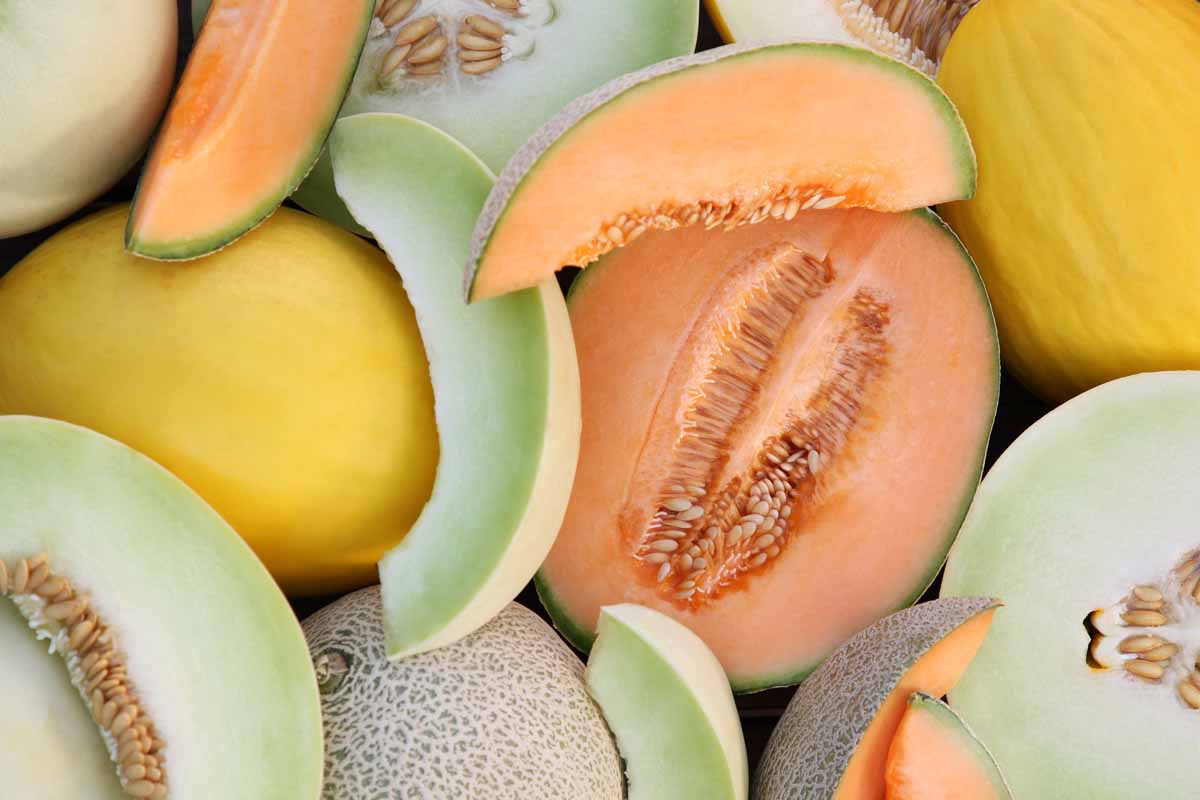
Are you leaning towards the warming spice flavor profiles or, like me, those that are more tropical and floral? Do you have any other favorites that I neglected to mention? Let me know in the comments section below.
And if you’re not done cultivating your melon knowledge, here are some more articles that will come in handy:
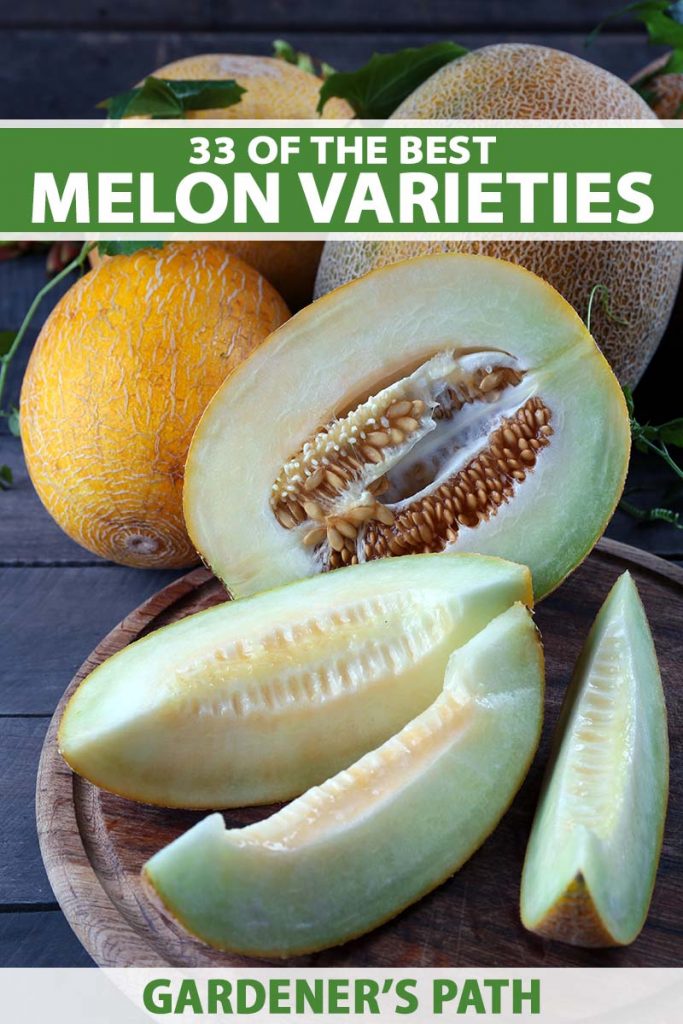


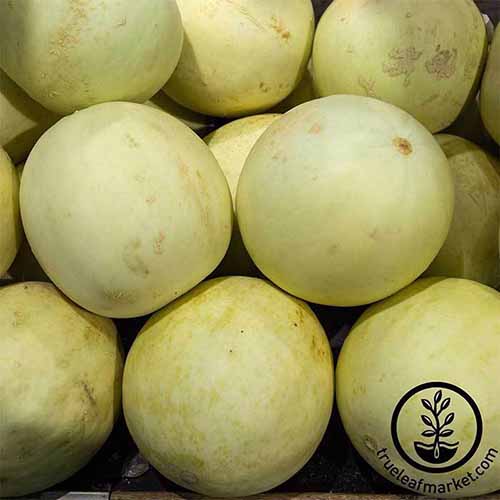
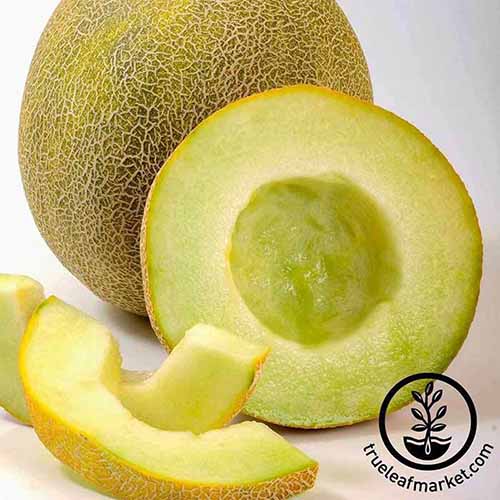
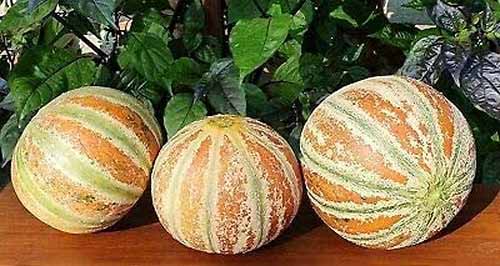

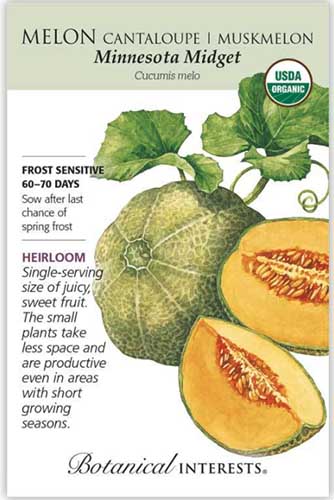
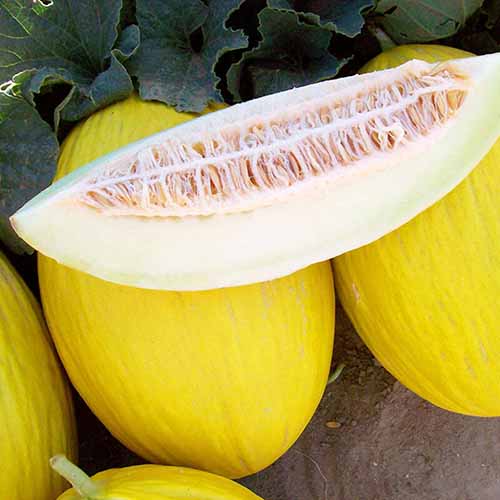


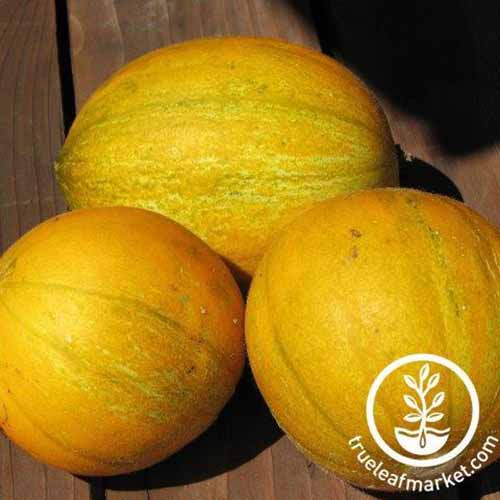
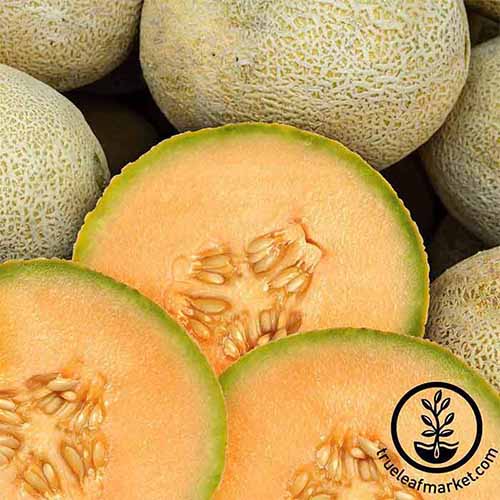



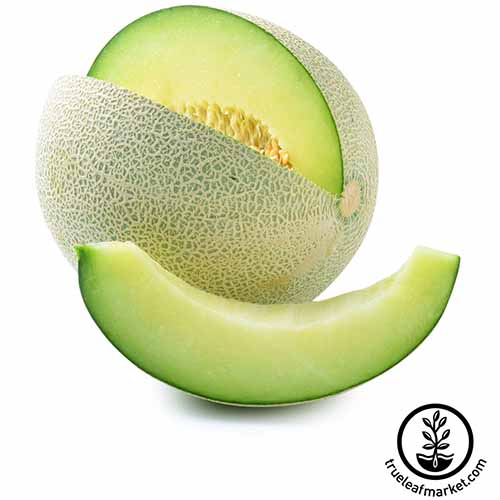
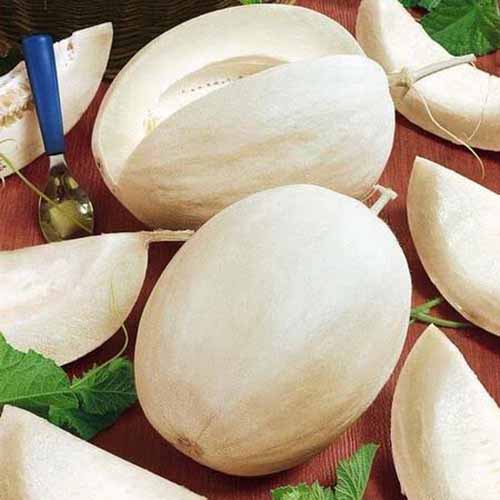
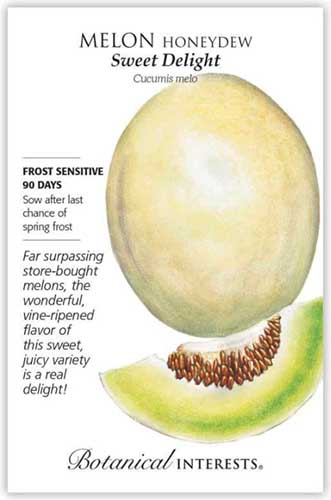
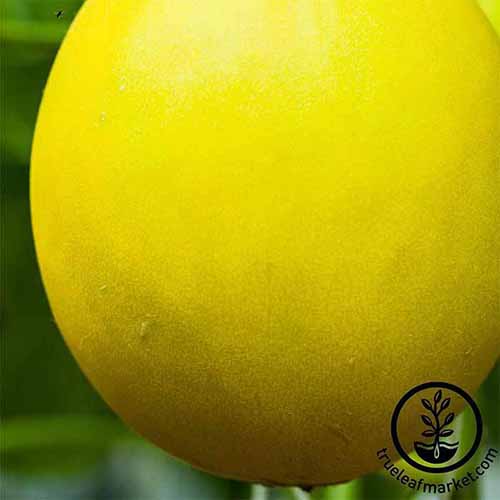
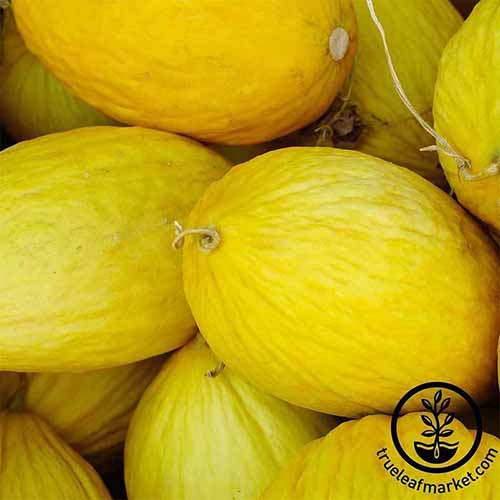
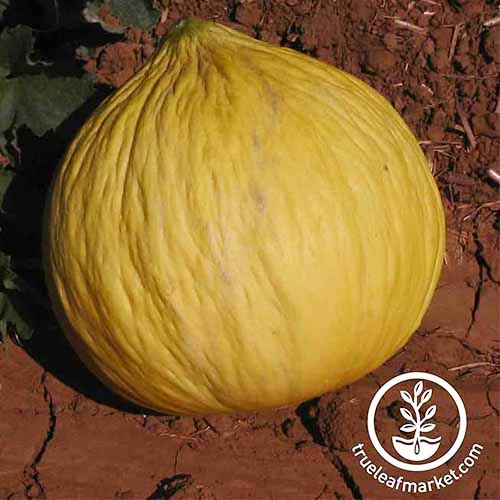

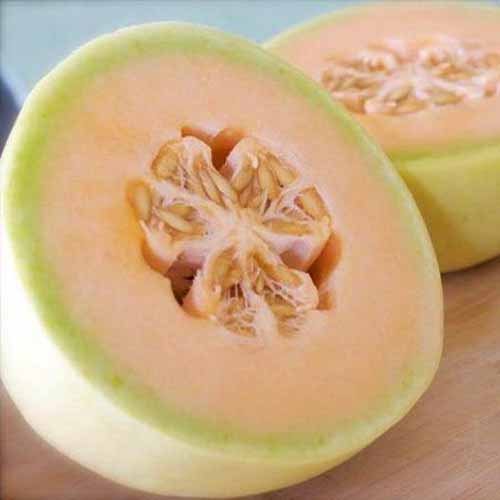
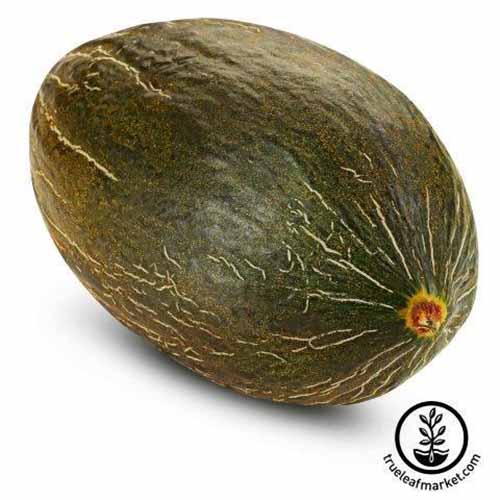

Thank you for your extensive list of melons! We are beginning to see some of these melons at our local produce stands.
Hi Janie,
I’m glad you found this melon list helpful. It’s always exciting to see some diversity at the farmer’s market or produce stand!
Enjoy and stay cool!
What Melon turns orange outside and has orange flesh with hard round grey seeds? Before turning orange its coloring looks like a combination zucchini and summer yellow squash. The skin is thin. Thank you for any info you can give me. It was a gift. I thought it was squash.
Can you share a photo, Marie? What shape is the fruit, and are the seeds teardrop-shaped? Is the skin smooth, netted, striped, ridged, or bumpy? If it is elongated at one end, this sounds like it could be a butternut, kabocha, or kuri squash. The Ananas melon is another possibility, which has yellow-orange flesh with netting and flesh of a similar color. Cucumis melo var. makuwa ‘Dae Jang Geum’ is another possibility- it’s an elongated Korean melon with orange skin that is striped.
I bought this melon from the store and it tasted super sweet. Can you help me identify the variety. It was only marked “Sweet Cantaloupe” at the store, which did not tell much – when cut, the flesh is deep orange! – Thank you!
Hi Del, Thanks for sharing your photo and posting your question. Your photo and description makes me think of one particular variety called ‘Blenheim Orange’ – currently sold out on Amazon, but I’m including a link here in case it comes back in stock. Unfortunately there are probably a dozen or more other melons that have a very similar appearance, so ‘Blenheim Orange’ is just a guess. Except for some of the really odd looking varieties, it is pretty hard to know the identity of a melon by looking at it. If you’re feeling particularly motivated to find out though,… Read more »
Years ago I found a cantaloupe that look like A zucchini orange on the inside
How interesting! The closest thing I can think of might be Thai muskmelons, though their flesh is more of an orangish green. Maybe our readers will see your comment and someone will recognize the variety you are describing!
I’m wondering if you might know of a “melon” my dad grew in the mid 70s. They were small, orange striped, but elongated not round, so not “Tigger”. The plants produced very heavily. The flesh when ripe was very sweet, sort of a cantaloupe orange color, around a chamber very heavy with seeds.
Any ideas? Whenever I search for small striped melon Tigger, Rich Sweetness, or Kanjari are about all that come up.
Hi Bruce, Thanks for posting your question here. Unfortunately none of the varieties I can think of tick all of the boxes in your description. There’s ‘Queen Anne’s Pocket’ melon which has striped orange skin, but it has white flesh and isn’t sweet. There are some striped Korean melons that are smallish and elongated, but with white flesh – and their skin is more yellow in color with white stripes. There are many different types of snap melons (melons that crack open when ripe), some have orange flesh and a large seed cavity, but the skin coloration and size doesn’t… Read more »
I’ve never been clear what days to maturity actually means. A melon that ripens in 80 days in Phoenix AZ isn’t going to ripen at all on Baffin Island. I interpret days to maturity as meaning the number of days the variety will take to ripen under ideal conditions for that particular variety. In my zone 4a, cool season crops (e.g. radishes) will be ready in almost exactly the number of days stated on the package. But I can only get the very shortest season melons (60-65 days) to ripen in my open garden despite having about 115 frost-free days… Read more »
Ian, As a short season gardener at a high latitude where cool nights are the norm during summer, I have the same issues with warm season crops growing slower than the estimated days to maturity. This is probably because most seed production is not happening in places with cool summer nights, so the days to maturity don’t reflect our type of climate. It can help to choose varieties grown locally, if you can find them, or at least from your region, where climatic conditions are similar. As you’ve noted, this is more of a problem with warm-season crops, which originate… Read more »